
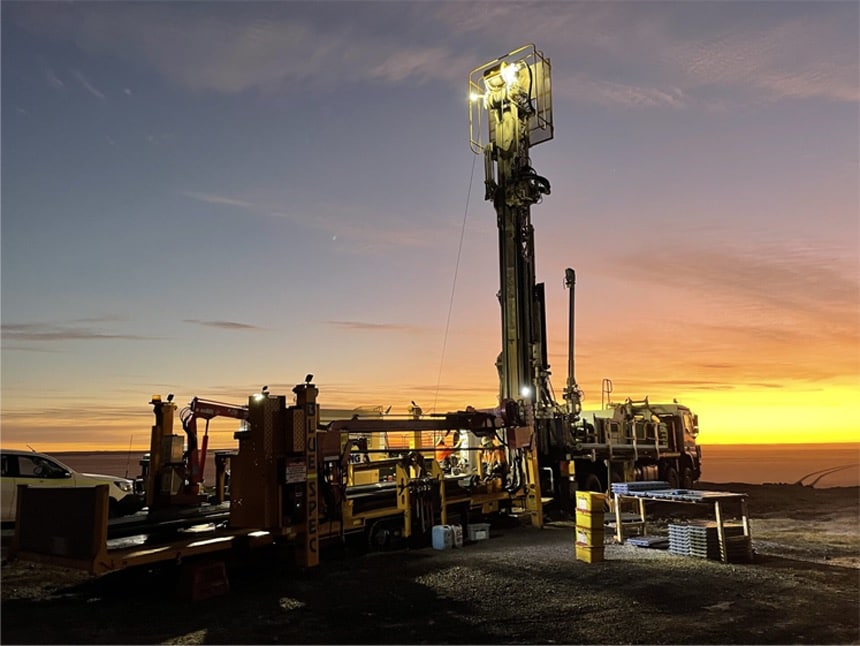
ORE RESERVES & MINERAL RESOURCE
Since listing on the ASX in June 2021 the Company’s nickel sulphide Mineral Resource has grown significantly, from 39,000 tonnes of nickel metal to now over 100,000 tonnes. The Company has also declared its first Ore Reserve at the Baker Deposit, its first discovery and now cornerstone asset.,
JORC (2012) Ore Reserves

Baker’s initial Ore Reserve estimate was reported to the ASX (22 May 2023) as part of the lodgment of the results of the Pre-feasibility Study (PFS) focused on Baker. It was compiled in accordance with the Australasian Code for Reporting of Exploration Results, Mineral Resources and Ore Reserves (JORC Code) 2012 Edition. The Probable Ore Reserve estimate is based on the Baker Mineral Resource estimate classified as Indicated Resource after consideration of all modifying factors determined by geotechnical inputs, mining methods, metallurgical characteristics, infrastructure, social, environmental, governmental, and financial aspects of the operation.
The grades and metal stated in the Ore Reserves estimate include diluting materials and allowances for losses, which may occur when the material is mined or extracted and is defined by a study at a PFS level as appropriate that includes application of modifying factors.
The Ore Reserve estimate is determined from a mine design, plan and production schedule that is technically achievable and economically viable. All material was subjected to an economic evaluation in a detailed cost model underpinned by the PFS analysis. The mine plan returns a positive net present value assuming a discount rate of 8%, and a flat nickel price assumption of A$35,294/t (US$24,000/t; 0.68 AUD:USD) was used for the Ore Reserve financial evaluation. Ore processing was assumed to be undertaken at the Kambalda Nickel Concentrator under an OTCPA with Nickel West. The PFS on which the Ore Reserve estimate is based demonstrates, that at the time of reporting, extraction could be reasonably justified.
JORC (2012) Mineral Resource Estimates
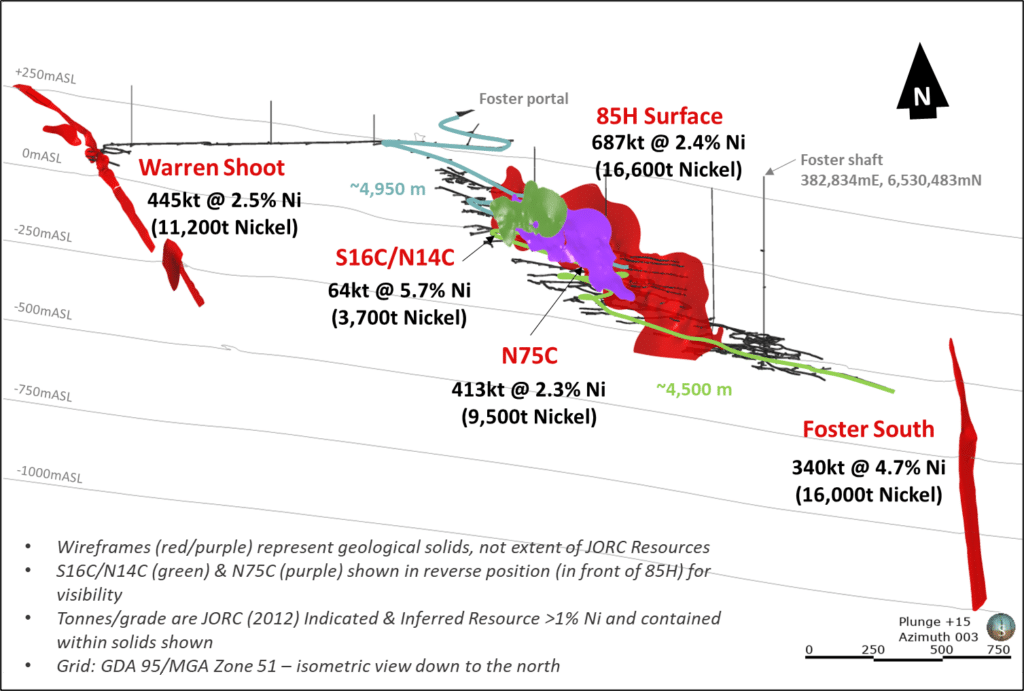
Prior to its IPO in June 2021, Lunnon Metals applied significant attention to the review and analysis of the former WMC reported mineral inventories to upgrade and report these in accordance with JORC 2012 guidelines. The work carried out by the Company included a detailed audit of the historical data and historical drill core that supports the current Mineral Resources, including:
• duplicate sampling with QAQC (insertion of certified reference material or sample standards)
• density determinations
• check geological logging
• mineralisation characterisation for metallurgical considerations
• historical section and plan reviews (in 2D and also in 3D as scanned and geo-referenced images)
• review of paper geology logs, assays and surveys cross referencing with the digital database
The above work led to the reporting of 39,000 tonnes of nickel metal in Mineral resource at the time of listing on the ASX.
In less than 3 years since listing this figure has now grown by 187% or 70,100t of nickel metal (averaging 2.7% Ni) with the addition of the N75C, S16c and N14C surfaces at the Foster nickel mine (again generated from the Historical Core Program), the exciting discovery of the Baker Deposit, addition of the nearby East Trough and in late 2023/early 2024, definition and reporting of the first Mineral Resources at the Silver Lake-Fisher Project with the 25H deposit and Fisher’s F Zone being added to MRE.
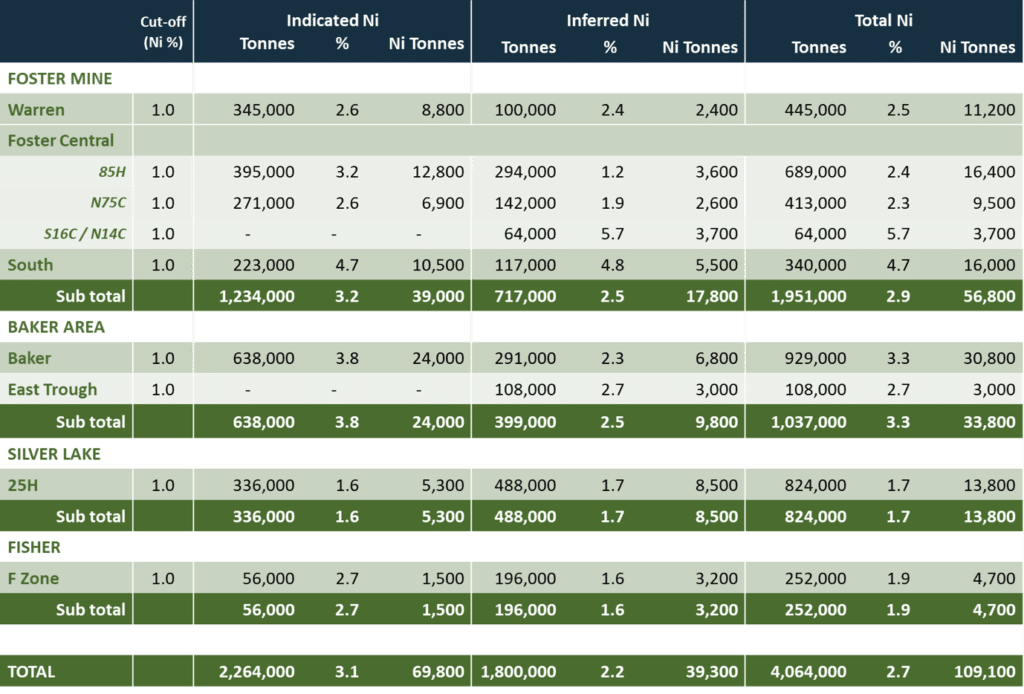
The current (15 January 2024) JORC Code (2012) Mineral Resource for the Kambalda Nickel Project is as follows (all reported above a 1.0% Ni lower cut off).
All material modifying factors have been considered and accommodated in the chosen reporting cut-off grade, which is >1.0% Ni. Refer to the ITAR in Schedule 3 of the Prospectus (dated 22 April 2021) released to the ASX for further details, the Competent Person and Important Statements for the Mineral Resources estimates for the nickel deposits on this website which also contain additional information required by ASX Listing Rules 5.8.1 and 5.8.2 and the ASX announcements dated 22 April 2022 (in relation to the N75C figures), 14 June 2022 and 7 December 2022 (in relation to the Baker Shoot) and the 11 January 2023 (in relation to the S16C/N14C figures), 31 March 2023 (in relation to Warren), 4 December 2023 (in relation to the 25H at Silver Lake), 18 December 2023 (in relation to East Trough) and finally 15 January 2024 (in relation to Fisher F Zone).
Baker Deposit
The Company reported the initial nickel Mineral Resource estimate for the Baker deposit, its first discovery at the Kambalda Nickel Project, in June 2022. In December of the same year, this estimate was updated following an aggressive infill RC and diamond drill campaign: The current Indicated and Inferred Baker Mineral Resource comprises (above a 1.0% Ni cut off):

This updated figure increased Lunnon Metals’ global Mineral Resource (at the time of reporting) across the KNP to 2.58 million tonnes @ 3.1% Ni for 79,300 contained nickel tonnes, an increase of 103% in contained metal since listing in 2021.
Completing the updated Baker Mineral Resource capped off a successful 2022 for the Company. It saw the Exploration Target at East Cooee converted via the discovery and drilling out of the Baker deposit to approximately 20m x 20m. Baker is understood to be the first new nickel discovery reported in a Mineral Resource in the immediate Kambalda nickel camp since Independence Group announced the discovery of the Moran nickel deposit at the south end of the Long-Victor mine in 2008.
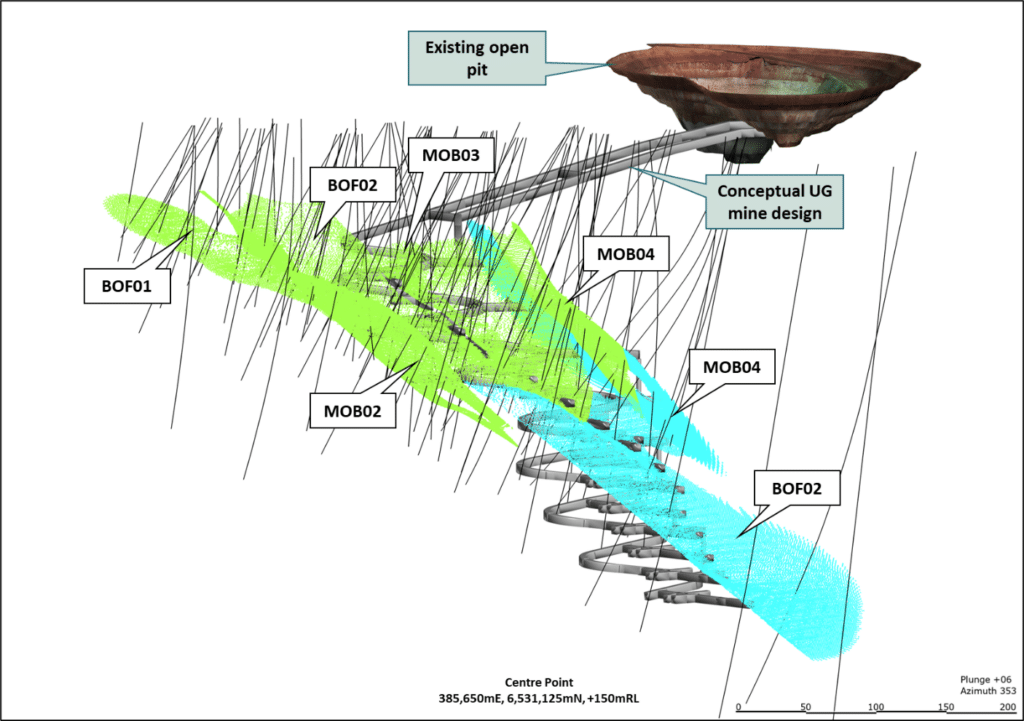
East Trough

The East Trough prospect, located adjacent to the Baker deposit, is currently recognised to extend for at least 1.2km between historical WMC surface diamond holes CD230 to CD546 with the depth to the prospective basalt contact ranging from 100m to 680m below surface over that distance. A near surface elongate 650m long nickel oxide anomaly greater than 0.3% Ni is positioned immediately above the trough trend at its north-western extent but has not been modelled or estimated.
The reported MRE itself is defined over a plunge extent of 550m within the currently understood trough structure. Historically, this trend was poorly tested with an irregular, WMC vintage (~1970s) drill hole spacing of approximately 250m at depth and 125m where shallow. Previous mineralised intercepts to date have tended to be relatively narrow. However, the presence of massive nickel sulphide at the important komatiite-basalt contact is considered a key indicator for prospectivity along the trough structure which is deeply incised into the underlying Lunnon Basalt footwall. The first-time Mineral Resource estimate for East Trough is:
85H deposit

The previous estimate for the 85H deposit was completed in January 2021, in preparation for the Company’s listing on the ASX later that year in June 2021. In late 2023, a metallurgical program of four surface DD holes was incorporated in an updated Mineral Resource estimate. The resultant estimate did not change materially, as the program was primarily aimed at collecting metallurgical sample. A minor decrease in nickel metal resulted from additional Specific Gravity (SG) data that refined the grade versus SG relationship for the modelled nickel sulphide mineralisation.
Insufficient WMC historical assay data exists for copper, cobalt and arsenic in the immediate vicinity of the MRE to report meaningful estimates for those elements. In this regard and as previously reported to the ASX, both the assay results for the Company’s own drilling and the metallurgical testwork indicated good copper and cobalt by-product credit levels and minimal arsenic present on the 85H (refer to ASX Announcements dated 1 August 2023, 8 February 2023 & 24 November 2022).
The breakdown of the updated MRE at a 1.0% Ni cut-off grade is as follows. Estimates were made for nickel and bulk density only.
Foster South

In December 2020, Cube estimated a Mineral Resource for the Foster South nickel deposit. As with 85H, drillhole data and geological interpretations were supplied by Lunnon Metals and Cube produced the estimate using standard processes and procedures including data selection, compositing, variography, estimation by OK and model validation. Estimates were made for nickel and bulk density as well as the minor elements of arsenic, cobalt, copper, iron, magnesium oxide (MgO) and sulphur. Furthermore, estimates were made for all variables in the background ‘halo’ domain (outside the mineralised lodes) for potential future mine planning purposes (e.g. dilution calculations).
Warren

In March 2023, Cube updated an estimate of the Mineral Resource for the Warren nickel deposit (formerly known as Foster NW). Drillhole data and geological interpretations were supplied by Lunnon Metals and Cube produced the estimate using standard processes and procedures, including data selection, compositing, variography, estimation by OK and model validation. The update followed a long drilling campaign started shortly after the Company’s IPO, that saw 13 reverse circulation (RC) drill holes (totalling over 2,000m) and 25 diamond drill (DD) holes (totalling over 7,300m) drilled throughout 2021 and 2022.
As reported to the ASX throughout the Warren drilling programme, multiple significant assay results have been recorded in gaps between the historical WMC drilling. Infilling these data gaps, whilst extending the geological and mineralisation interpretation to provide continuous models for both, underpins the increase in the estimate reported today.
Infilling the data gaps has greatly enhanced the overall understanding of the nature and distribution of nickel mineralisation in the Warren channel. Importantly, the Lunnon Metals drilling campaign has confirmed that nickel mineralisation is not restricted to what was previously interpreted as a narrow main channel environment. Rather, the new data has materially extended the footprint of the deposit. Previously, the channel was modelled to an approximate 40 metres to 50 metres width with only very minor flanking mineralisation (i.e. nickel intercepted outside of the channel margins).
The current interpretation records mineralised channel widths of 50 metres to 100 metres including extensive flanking nickel mineralisation. In the plunge orientation, the Warren channel is now modelled as hosting >1,200 metres of continuous mineralisation, whereas previously the interpretation was limited to a discontinuous 750 metres.
N75C
In March/April 2022, Cube estimated a Mineral Resource for the N75C nickel deposit. The N75C Mineral Resource comprises the laterally continuous N75C, 18C and 24C nickel surfaces. The N75C is a flanking basal contact surface located up-dip from the main incised Foster nickel channel. The N75C mineralisation itself is of moderate nickel grade largely characterised as 5-40% disseminated nickel sulphides increasing in intensity towards the base where there can be a narrower zone of stringer to massive nickel sulphides.
To the south the N75C surface continues and becomes the 18C and sitting down flank of the N75C and 18C (and immediately above the main Foster channel) is the 24C which has a footwall almost exclusively of Lunnon Basalt. Estimates were made for nickel and bulk density. There has been previous mining at N75C, so mining depletion was required and applied.

The N75C surface was one of the many nickel surfaces mined during the operational life of the Foster mine. Total mine production recorded over 61,000 tonnes of nickel metal produced from some 2.37 million tonnes of ore. The location of these newly estimated nickel surfaces relative to the Foster workings are shown below.
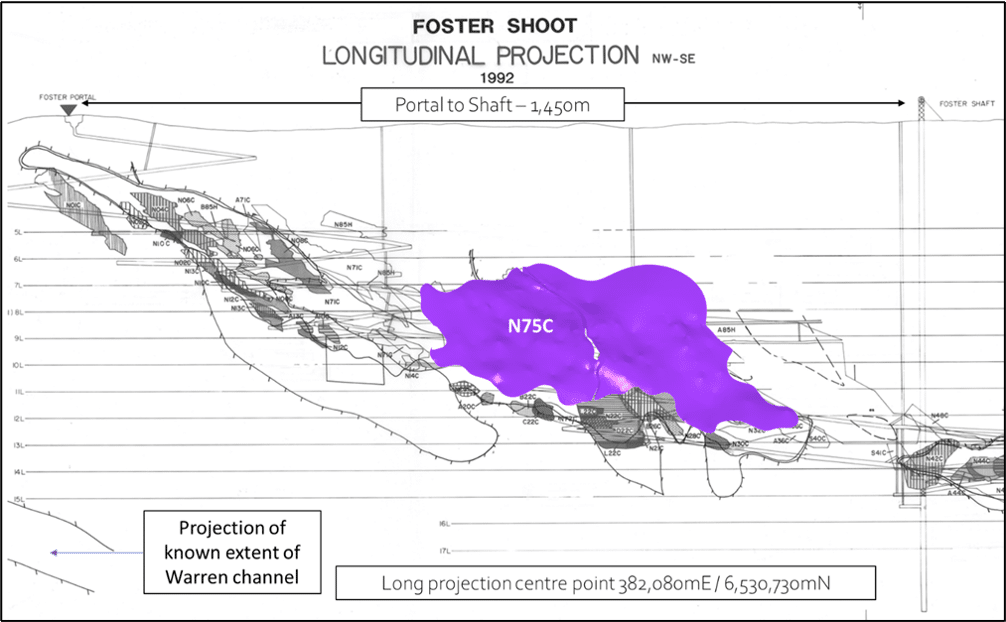
S16C

The S16C and N14C surfaces were some of the many nickel surfaces mined during the operational life of the Foster mine. These mineralised surfaces are part of an extensive suite at Foster that are in a flanking position at the base of the Kambalda Komatiite on the Lunnon Basalt footwall contact, which is interflow sediment covered in the case of S16C and partially sediment covered for N14C. This flanking position extends up-dip (up-flank) from the main Foster channel. The S16C/N14C surface is on the footwall side of a late intermediate dyke which splits this surface from the N75C mineralised surface (reported to the ASX on 22 April 2022), which is on the hanging wall side of the intermediate porphyry.
25H- Silver Lake Mine

The 25H is located at the south end of the Silver Lake mine, at the Kambalda Nickel Project. This first-time MRE follows receipt of final assays from the Company’s first pass surface diamond drill (DD) program into the deposit. The 25H MRE stands at 824,000 tonnes at 1.7% nickel for 13,800 contained nickel tonnes, comprising:
F Zone – Fisher Mine

The Fisher mine and the nickel shoots it hosts are developed on the southwest flank of the Kambalda Dome, with the historical workings plunging for approximately 1.1km to the south-southeast and extending over a vertical distance of at least 540m (from surface to approximately 215m below sea level).
The 50C and 60H surfaces are located in an area that was termed F Zone during the operational life of the Fisher mine.
F Zone was the largest contributor in terms of available mineable nickel mineralisation under the previous WMC system of classification and was reportedly a source of high-grade production.
Sign Up for ASX Alerts and News to receive the latest updates, insights, and developments directly to your inbox.